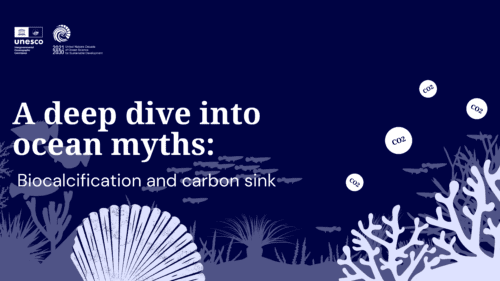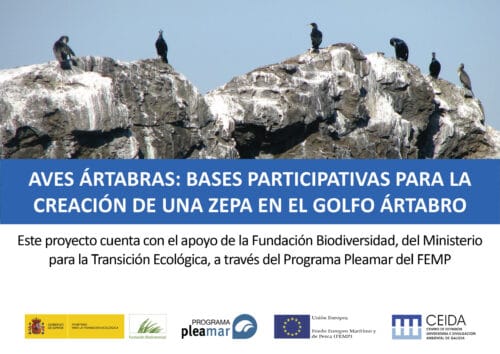Ocean Literacy commentary: “marine biocalcification and CO2 emission”

Author: Placido Benzi
Lay summary
Marine biocalcification is a biologically-mediated process through which Calcium Carbonate -CaCO3– is produced and used to build various components of the organisms, such as shells, plates and skeletons. Since the molecular formula of Calcium Carbonate contains an atom of Carbon, it is widely assumed that biocalcification is a practical and scalable way to sequester carbon, thus CO2 , to mitigate climate change and lessen the buildup of CO2 in the atmosphere. This rationale is commonly found in various instances related to communication initiatives -articles and posts on tabloid and social media- and even in technical and scientific spheres, such as in startups and scientific papers. The circulation of such unsupported views could lead to fallacious assumptions on the role of different ecosystems and organisms in the natural marine carbon cycle, or to the donation of large public funds to marine carbon dioxide removal -mCDR- enterprises with ambiguous theoretical basis.
Contrary to the myth, precipitation of Calcium Carbonate, such as in the case of a farmed mussel producing its shell, is a source of CO2 to the marine environment and possibly, to the atmosphere. Furthermore, this process leads to a secondary effect: for each “quota” of Calcium Carbonate produced, alkalinity, the Ocean’s capacity to buffer and hold CO2, diminishes by a factor of 2.
The chemical implications of CaCO3 precipitation are especially important to assess the role of different marine ecosystems in the CO2 mitigation landscape. The status of an ecosystem on this regard, though, relies on the equilibrium or difference between the scale and rates of CO2 producing processes and CO2 absorption processes, such as in tropical seagrass meadows exhibiting high rates of photosynthesis and organic carbon burial along with CaCO3 accumulation and community respiration. Coral reefs, for instance, are considered net source of CO2 taking into account all the processes acting therewithin. To conclude, it is important to highlight that the climate change discourse is currently dominated by a “Carbon reduction dominance” and that coral reefs are extremely important for biodiversity and functional ecosystem connectivity notwithstanding their contribution to CO2 reduction.
Background and context
“Coral reefs are important players in CO2 sequestration”
“This startup farms mollusks to mitigate CO2 emission through biocalcification”
The race to mitigate and absorb anthropogenic CO2 emissions in the atmosphere has led to a multitude of projects and initiatives of varying scientific rigor. The availability of financial benefits and government funds without a proper assessment, monitoring, and verification iter can certainly promote fallacious projects based on uncertain or false theoretical basis. This issue is also reflected in the public discourse landscape, which is not free from these ambiguities and is especially subject to reinforced circulation of false assumptions on how the ocean works, as seen in the previous case on the Myth on the fate of Oxygen in the Ocean. In certain instances, distortion of scientific knowledge can be quite poignant, and likely caused by the complexity of the topic, such as in the case of the erroneous biogeochemical implications of biocalcification in the context of CO2 mitigation, commonly presented as different articulations involving the attribution of blue carbon sink status to coral reefs or farming mollusks to absorb CO2 through their shells. The biocalcification process, which turns something invisible to the naked eye into something tangible -the shell-, is thus particularly subject to fallacy, and it is often portrayed as a way in which carbon is permanently locked inside the shells, with obvious positive consequences for the climate. Thus, it is commonly thought that inducing the precipitation of calcium carbonate -CaCO₃– from seawater is a viable way to sequester carbon in a solid form, which can be safely and conveniently stored.
Addressing the myth
The fallacy behind these assumptions stands in thinking that sequestering any sort of carbon is automatically translatable to reducing atmospheric CO2 over short time scales (~100 years). The Ocean contains a reservoir of carbon sixty times larger than the atmosphere. The inorganic carbon contained in the ocean is partitioned into four different species: free carbon dioxide or carbon dioxide gas in solution CO2aq, carbonic acid H2CO3, bicarbonate HCO3– and carbonate CO32- , although the concentration of carbonic acid is less than 0.3% that of CO2 and is thus considered negligible. The complex of the different dissolved forms is called total dissolved inorganic carbon, denoted by DIC and constituting the largest carbon reservoir on Earth excluding terrestrial rock other than coal.
Despite the near-surface waters supersaturation states, precipitation of Calcium Carbonate in the modern Ocean is a virtually exclusively biologically mediated process, while abiotic precipitation, due to the effects of dissolved Magnesium and organic matter, is practically neglectable; the modern biocalcifying organisms reside in the open ocean -coccolithophorids, foraminifers, pteropods- or alternatively in shallow coastal regions -coralline algae, corals-, and are able to secrete plates and shells of two phases of CaCO3,, namely calcite and aragonite, each characterized by different solubilities and stabilities. In any case though, precipitation of CaCO3, contrary to the myth, releases CO2 in the environment and depletes DIC.
Ca2+ + 2HCO3– ↔ CaCO3 + H2O + CO2
It should be noted that though it seems that for each mole of CaCO3 deposited, a mole of CO2 is liberated in buffered seawater, only approximately 0.5-0.9 moles of CO2 are liberated per mole of CaCO3 deposited, depending on salinity, temperature and carbonate chemistry. Notwithstanding the magnitude though, precipitation of calcium carbonate constitutes a source of CO2.
Furthermore, precipitation of calcium carbonate is one of the major processes affecting alkalinity. In simple terms, alkalinity represents the capacity of the Ocean to hold CO2, and biogenic precipitation of one mole of CaCO3 reduces alkalinity by two moles, thus reducing the buffering capacity of the Ocean in the context of an increase in acidification induced by an atmospheric CO2 input.
Coming back to the reaction, where does the carbon locked in calcium carbonate come from then?
The silicate-carbonate cycle
The HCO3– participating as a reagent in the reaction and related to the pool of DIC in the ocean comes from weathering processes on land that involve the reaction of atmospheric CO2 with silicate and carbonate rocks. Two thirds of the HCO3– carbon produced by weathering and exported to the ocean by rivers come from atmospheric CO2, while the remaining quota comes from the dissolution of Carbonate rocks. Essentially, biogenic CaCO3 formation represents the major way in which part of the CO2 depleted by land weathering returns from the Ocean to the atmosphere. The second step of this cycle (carbonate-silicate cycle) which exerts primary control on atmospheric CO2 levels over geologic timescales, involves the return of the remaining quota of CO2 by metamorphism-magmatism processes that reconstitute silicate rocks and degassing through volcanism.
Practically, calcification is the major and initial step according to which CO2 taken up during the weathering of land rocks is again released to the system, while the remaining quota of CO2 is freed during the transformation of carbonate rocks in the mantle and the reconstitution of silicate rocks.
Conservation implications
As we’ve seen, calcification is a source of CO2, so ecosystems characterized by high rates of calcification could result in net CO2 source to the atmosphere in certain cases. Ecosystems with high rates of primary productivity dominated by calcifying organisms, such as tropical seagrass meadows, are difficult to assess since they rely on a dynamic equilibrium of CO2 reduction processes -photosynthesis, CaCO3 dissolution- and CO2 emission processes -respiration, CaCO3 precipitation-. In the case of other major ecosystems characterized by high rates of calcification coupled with low primary production and organic carbon burial, such as coral reefs, the uncertainty lessens and verges toward a consensus which sees them as net CO2 sources to the marine environment and, possibly, to the atmosphere, depending on the difference in the partial pressure of CO2 (∆pCO2) between the two reservoirs.
This rationale should not discourage conservation efforts directed towards coral reefs or any sort of ecosystem characterized by high calcification rates which offset the net carbon absorption potential. The discourse on climate change is suffering from a “dominance of Carbon” which is effectively obscuring other important aspects such as biodiversity and ecosystem services. Coral reefs remain extremely important and priority habitats notwithstanding their carbon mitigation potential per se.
Summary:
- Calcification releases CO2 into the Ocean and possibly into the Atmosphere
- High rates of calcification could render an ecosystem net heterotrophic or net source of CO2
- Coral reefs are slight emitters of CO2 and do not constitute CO2 sinks
- In light of these considerations, Carbon dominance in the climate discourse may come with the risk of lessening the conservation efforts targeting calcifying organisms
References:
https://doi.org/10.2475/ajs.283.7.641
https://doi.org/10.4319/lo.1994.39.2.0458
https://doi.org/10.1007/BF00255465
https://doi.org/10.1073/pnas.96.23.13017
DOI: 10.2138/gselements.15.4.235

